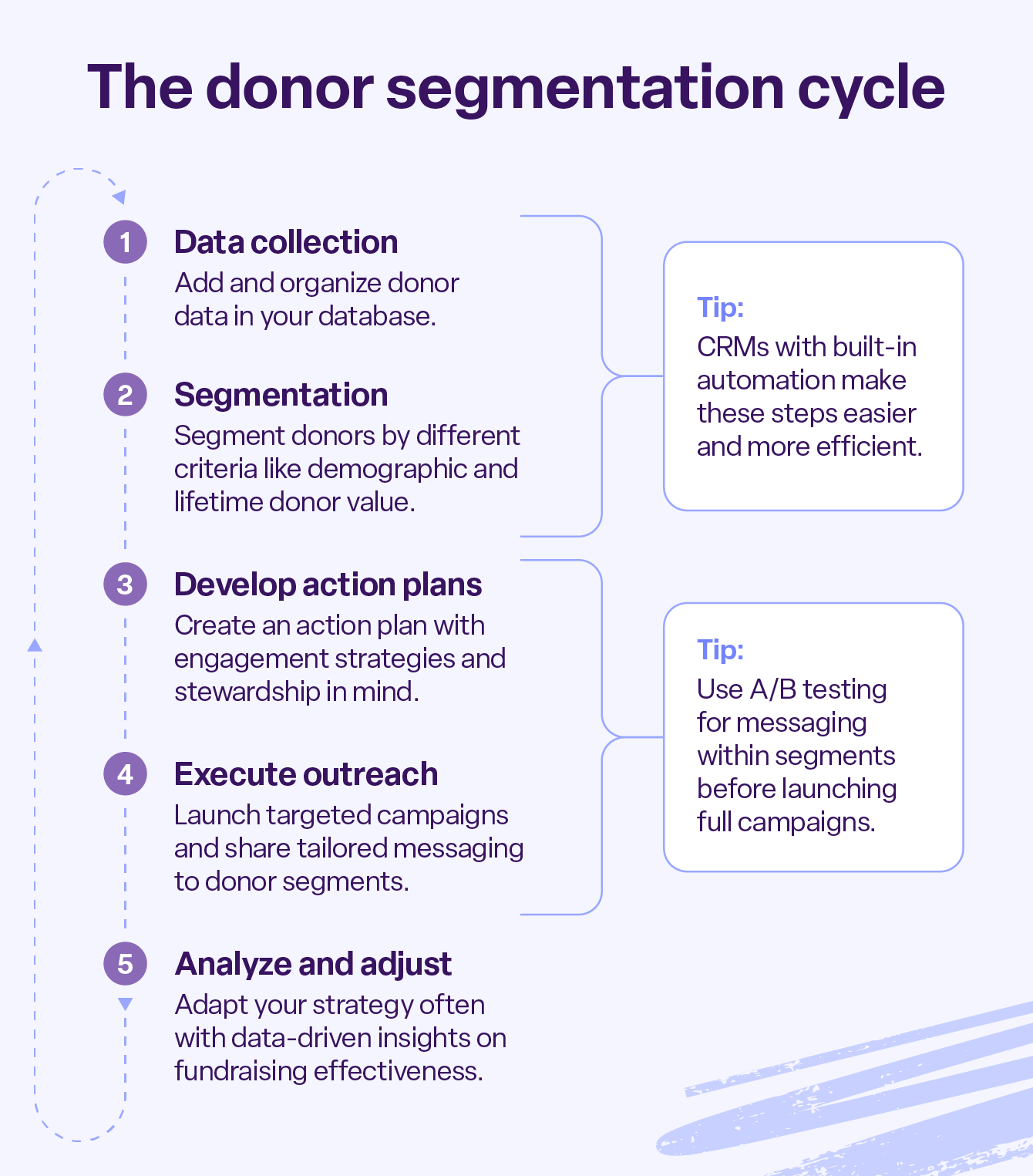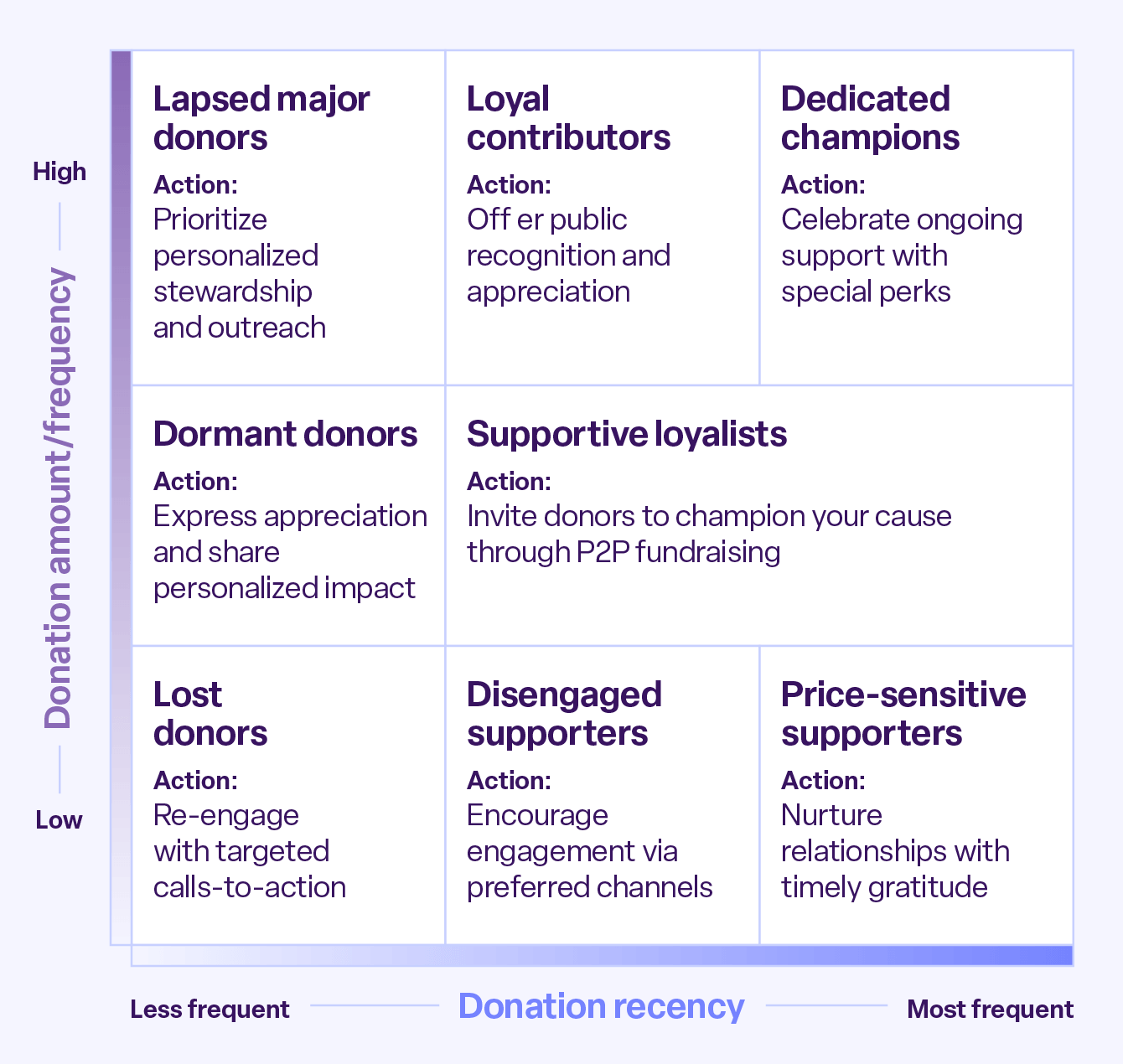Donor segmentation guide: How to engage donors and boost fundraising ROI

As donors engage with your organization, you learn who they are, what they’re passionate about, and what kind of experiences they enjoy. But collecting that data is just the first step. To maintain strong donor relationships over time, put that data to use by personalizing your communications through donor segmentation.
By using donor segmentation to group your contacts by qualities like demographics or interests, you can personalize the donor experience for each person — even if you have hundreds or thousands of supporters in your database. The easiest way to do this is with donor management software like CRMs that keep all donor information in a single place and let you send the right messages at the right time.Segmenting donors allows you to tailor outreach at scale, leading to more meaningful interactions, improved relationships, and increased donor retention rates. In this guide, we’ll explore donor segmentation and several strategies to boost engagement.

What is donor segmentation?
Donor segmentation is the process of dividing your organization’s supporters into groups based on shared characteristics like interests, age, or giving cadence. It’s essential for effective donor management and writing fundraising appeal letters, regardless of the size of your nonprofit’s donor base.
The donor segmentation process typically involves a few steps:
- Entering relevant data in your donor database
- Analyzing engagement data
- Breaking donors into segments
There’s no limit to the number or scope of donor segments you create. You might create a large segment for mid-level donors, for instance, then break the group down into many smaller segments based on giving frequency, potential for upgrade, and more.

Why is fundraising donor segmentation so important?
Strategic donor segmentation shows donors you’re paying attention to their interests, helps with stewardship efforts, and inspires more engagement and loyalty.
For example, say you send personalized online auction invitations to a group of donors who love events but live out of town. These donors will likely jump at the chance to engage with your nonprofit in a way they enjoy, and they’ll appreciate that you took the time to consider their needs.
Ultimately, these donors will be more likely to continue supporting your organization long-term.
Engage your donors with personalized communication
Personalize appeals and outreach for each group, speaking directly to their shared interests or needs to boost engagement. This makes it clear that you value each donor individually and appreciate their support of your organization.
Foster donor loyalty and retention
Thoughtful segmentation helps your donors feel seen and appreciated for their unique qualities and interests. When your outreach reflects their individual motivations and contributions, donors are more likely to feel valued and stay engaged.
Boost fundraising efficiency and ROI
Segmentation lets you target the right donors with the right message at the right time, which can increase their likelihood of conversion. This leads to your campaigns being more cost effective and generating a higher return on investment.
Save your team time and effort
Using software to segment donors into clear groups can streamline your workflow by reducing guesswork and manual sorting. Segmentation makes it easy to determine who to message when, so your team can tailor messages and launch campaigns quickly, freeing up time for higher-value work.
5 common donor segmentation categories
Organizations often segment their donors using factors like demographics, interests, and preferences. Over time, these segments prove useful for year-end stewardship and other fundraising requests.
Demographics
Demographic data can indicate common preferences and beliefs: for instance, donors belonging to Gen Z are more likely to engage with your nonprofit on social media and support social justice causes. By segmenting donors based on their demographics, you can more easily cater to these preferences.
You likely have plenty of demographic information about your donors already, including:
- Age
- Gender
- Location
- Career field
- Marital status
- Income
- Education level
The more you can hone your segments, the more effective they’ll be. Rather than relying solely on demographics, use other types of donor data to refine your segments.
For example, you might create a segment that is made up of Gen Z donors who work in STEM fields or a segment of local retired donors who volunteer at least once a month.
Engagement
Your donors engage with your organization in several ways beyond giving. Noting how different groups engage helps you tailor your outreach, ensuring that you offer the right activities to the supporters most likely to accept them.
A donor’s engagement history takes into account involvement like:
- Volunteering
- Attending events
- Fundraising on your organization’s behalf in a peer-to-peer fundraiser
- Advocating for your organization
- Serving on your board or a committee
For easier donor segmentation, consider quantifying supporters’ engagement levels to quickly gauge which donors are highly engaged. Streamline this process with donor engagement software by assigning supporters points based on their involvement history.
Additionally, you can group donors based on how often or how regularly they give. This helps you tailor fundraising appeals and send them at the most impactful times. Using this donor segmentation strategy, you might create segments for:
- Monthly or recurring donors: Those who give regularly, usually with automatic payments through a recurring giving program.
- Annual donors: Supporters who give their largest contribution to your nonprofit at the same time each year.
- Repeat donors: Those who don’t follow a standard giving frequency but tend to donate more than once a year.
- Lapsed donors: Supporters who donated in the past but have since stopped giving.
Send thank-you messages to recurring donors, and set up a trigger in your database to remind them when their payment method expires. Annual donors, on the other hand, might receive regular updates about your organization’s work but limited fundraising appeals until the time of year when they typically make their donation.

Interests
Each donor has their own reasons for giving to your organization. The more you can appeal to these motivations in your fundraising appeals, the more likely you are to earn their donations.
Whenever you learn that a donor aligns with a specific aspect of your cause, add them to a donor segment so you can tailor future appeals and outreach efforts.
Donor interests may include:
- Specific program areas (such as youth services, animal welfare, or LGBTQ+ rights)
- Event participation or enthusiasm (including galas or auctions, volunteer days, or runs)
- Policy or advocacy interests
- Support for specific populations, like the elderly or veterans
- Passion for education, art, or other areas
- Preferences for financial contribution or hands-on volunteer work
For example, a human rights nonprofit might create segments for donors most interested in amnesty, racial justice, and LGBTQIA rights.
Preferences
You can gather information about supporters’ communication preferences through direct methods like surveys or by analyzing their engagement with your messages. Then, use donor segmentation to help you adhere to these preferences, boosting the chances that donors will read and interact with your communications.
For example, communication preferences might include:
- Text messages/SMS
- Email newsletters
- Personalized emails
- Phone calls
- Physical mail
If a donor only responds to text messages, for instance, place them in a segment of supporters who favor SMS. You might still send occasional emails to these donors but focus your outreach strategies on text messages.
Giving potential
If your organization is new to donor segmentation, start dividing your donors up by giving level.
These segments are essential for recognizing every supporter appropriately. Those who give at higher levels expect (and deserve) more thorough appreciation efforts, such as a handwritten thank-you letter instead of an email.
Before segmenting donors, some nonprofits create a visualization called a donor pyramid to define giving levels and their criteria. If you’re unsure what qualifies as a minor or major donation for your nonprofit, this is a good first step.
You can then break these segments down further for more tailored communications. This might look like a segment of first-time minor donors who gave less than $100 or a group of mid-level donors who mainly give at fundraising events.
Consider creating segments for:
- Micro donors: Those who typically give small amounts, such as $10 or less.
- Minor donors: Those who aren’t quite micro donors or major donors, but give a significant amount.
- Mid-level donors: Those who contribute around $1,000 to $10,000, depending on the organization’s size.
- Major donors: Those who make large contributions, often $25,000 or more.
General giving level segments are valuable but don’t allow for enough personalization without breaking them down into smaller groups.
Engagement strategies for essential donor segments
Once you have your segments broken out, it’s time to determine how to best appeal to each.
Prospective major donors
Prospective major donors are people with the capacity and inclination to make a major gift to your organization. To engage them, you need a highly personalized, white glove approach that cultivates a strong relationship and highlights the impact you can have together.
Tip
Focus on tailored outreach, individual stewardship, and invitations to see your mission in action.
First-time donors
First-time donors are those who have not previously given to your organization but have taken a step toward your mission. Engage them by making their first experiences memorable and meaningful.
Tip
Leverage prompt onboarding, heartfelt thank-you messages, and explanations of how their gift will make an impact.
Recurring donors
Recurring donors typically commit to monthly or annual giving, which gives your organization stable and predictable revenue. These donors have demonstrated their interest and trust in your organization, so it’s important to keep them interested.
Tip
Keep donors engaged through updates and reminders of the impact of their ongoing gifts.
Lapsed donors
Lapsed donors have given in the past but haven’t contributed within a typical recent giving window. Regain lapsed donors by first digging into why they stopped giving.
Tip
Leverage personalized, warm outreach messages to acknowledge their past generosity and share updates on your organization, then offer simple ways to reconnect.
Annual donors
Annual donors give reliable, once-a-year donations. While they are likely highly aligned with your mission, they may not be as engaged throughout the year.
Tip
Keep annual donors engaged with consistent recognition, updates, and reminders. You can also highlight opportunities for deeper involvement in a low-pressure way.
Engaged non-donors
Engaged non-donors are individuals who interact with your organization through volunteer work, event attendance, or simply reading your content — but they haven’t made a financial contribution. They’re ideal targets for conversion since they already clearly care about your mission.
Tip
To convert them, offer easy, low-barrier opportunities to give and emphasize the impact small gifts can make in addition to the impact their involvement already has.
Donor segmentation best practices
There are countless ways to create highly specific, effective segments. Use these baseline strategies to compile and leverage the best donor segments for your organization.
Develop meaningful, specific donor segments
Determine the groups that are most relevant to your goals and align your segments. For instance, newer nonprofits might not have a significant major donor segment yet. Organizations supporting social justice causes need to heavily factor advocacy campaign involvement into their segmentation strategy.
Include volunteers
Your fundraising segmentation strategy can also help you understand and engage with volunteers, who help further your purpose in different yet essential ways. Track volunteer-to-donor conversions, offer tailored opportunities to different volunteer segments, and leverage volunteer grants.
Create an action plan and build strategy around donor segmentation
Design plans that break down how you will target different donor segments and over what timeframe. Each plan should support a specific goal and guide your team’s efforts to reach every supporter in the most personalized, relevant ways. For instance, you might create a stewardship matrix that outlines how you’ll thank and steward donors at each giving level.
Your completed plan of action should inform your nonprofit’s fundraising strategy. As you choose fundraising initiatives each year, review the previous year’s data and consider the preferences of your most important donor segments.
Adapt your fundraising donor segmentation strategy often
Your goals will shift as your nonprofit grows, and your donor segmentation strategy should evolve accordingly. On a regular basis, such as annually, be sure to consider how your goals have changed, if any segments are missing, and if there are better ways to support your objectives.
You may also consider triggers —such as new campaigns, changes in donor behavior, and donor information changes — as a reminder to take a look at your overall strategy and segmentation.
Boost your fundraising strategy with donor segmentation
The more you know about your donors, the better you can leverage that knowledge via donor segmentation. And it builds upon itself: As you engage your unique segments, the better you’ll understand your community and connect with each supporter.
Donor management software like Bonterra can make a major difference in your ability to track and use the right data for segmentation and data-driven decision making. Over time, continue evaluating your strategy and keep your donor segmentation information up to date to improve fundraising outcomes.
Segment donors and tailor appeals easily with Bonterra EveryAction and Bonterra Network for Good. Request a demo today.

FAQ
What does segmentation mean in fundraising?
Segmentation is the process of dividing donors into groups based on shared characteristics, such as demographic details, interests, and engagement level. This lets you personalize your outreach and asks, ultimately improving fundraising results.
What are the categories of donors?
Common donor segmentation categories include first-time donors, recurring donors, annual donors, major donors, lapsed donors, and engaged non-donors.
What are the 5 stages of segmentation?
The five stages of segmentation typically include identifying your goals, collecting and organizing donor information, defining segments and their criteria, grouping donors, and creating strategies for each group.
What does beneficiary segment mean?
A beneficiary segment refers to a group of people your programs are designed to serve. Segmenting beneficiaries can help your organization tailor its services and better measure impact.
How does segmentation support donor cycle fundraising?
Segmentation supports fundraising by strengthening every part of the cycle, from identification to cultivation to stewardship. It ensures each supporter receives messaging reflecting their unique interests and needs, leading to stronger relationships and more effective fundraising.
Work with Bonterra



